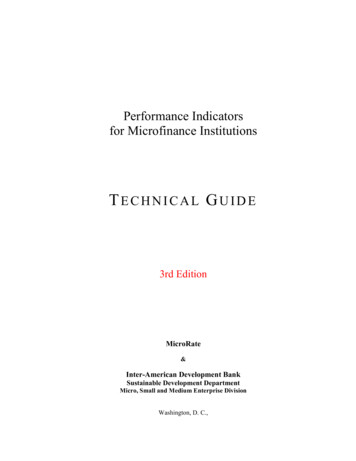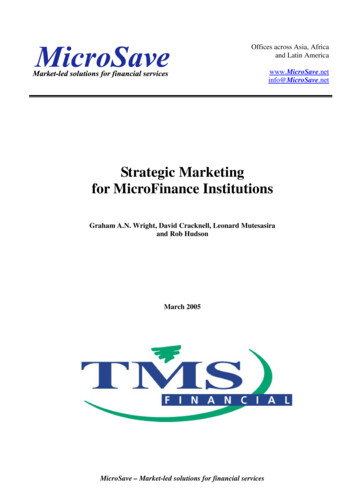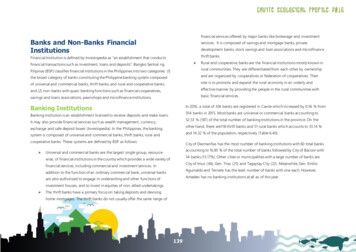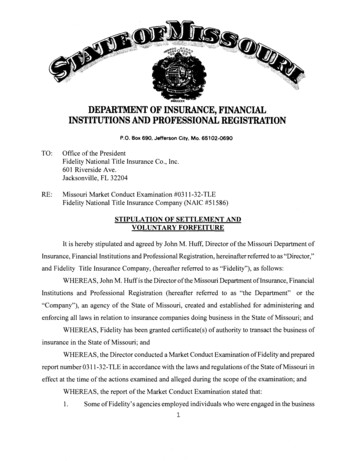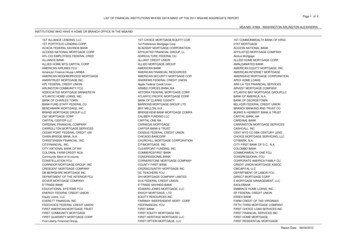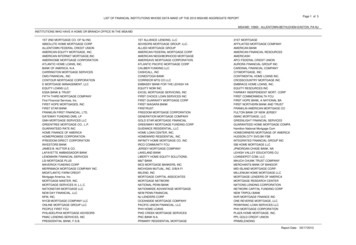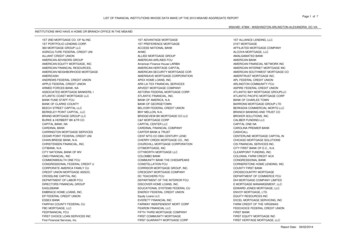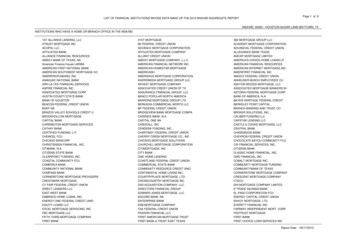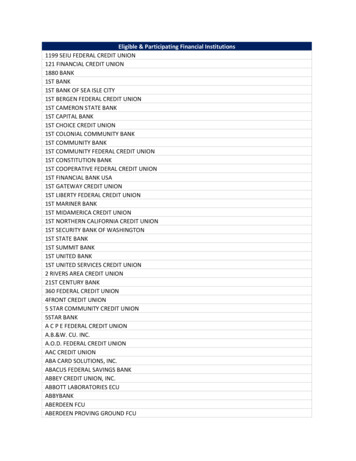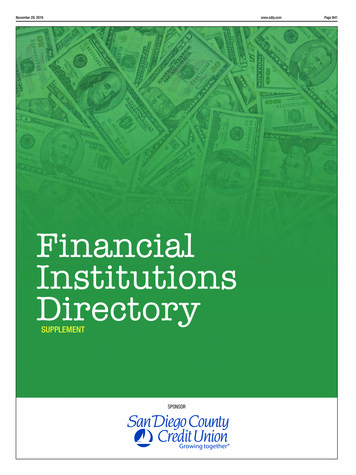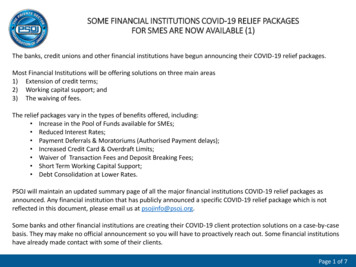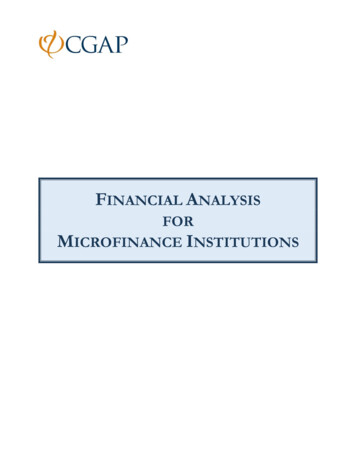
Transcription
FINANCIAL ANALYSISFORMICROFINANCE INSTITUTIONS
2009 Consultative Group to Assist the Poor/The World Bank. All rights reserved.Consultative Group to Assist the Poor1818 H Street, N.W.Washington, DC 20433Internet: http://www.cgap.orgEmail: cgap@worldbank.orgTelephone: 1.202.473.9594
Table of ContentsAcknowledgments.ivIntroduction.vOverview of the Course .viiReferences for the Course .ixCourse MaterialsSession 1: Welcome and Introduction .FA-1Handouts.FA-27Session 2: Overview of Financial Statements and Other Managerial Reports.FA-41Handouts.FA-69Session 3: Accounting System .FA-81Handouts.FA-91Session 4: Formatting Financial Statements.FA-101Handouts.FA-179Session 5: Overview of Financial Analysis.FA-221Handouts.FA-229Session 6: Portfolio Quality.FA-241Handouts.FA-259Session 7: Analytical Adjustments.FA-289Handouts.FA-315Session 8: Asset/Liability Management.FA-335Handouts.FA-347Session 9: Efficiency and Productivity .FA-363Handouts.FA-377Session 10: Sustainability and Profitability Analysis.FA-395Handouts.FA-417Session 11: Putting It All Together.FA-437Handouts.FA-453Session 12: Action Plan, Audit, Evaluation, and Closure.FA-485Handouts.FA-489iii
AcknowledgmentsCGAP would like to thank those who were instrumental in the development and design of the original“Financial Analysis for Microfinance Institutions” course and its update in 2008: Janis Sabetta, BrigitHelms, Jennifer Isern, Michael Goldberg, Ruth Goodwin-Groen, Lorna Grace, Patricia Mwangi,Brigida Octavio, Agata Szostek, MICRA, Indrajith Wijesiriwardana, Ann Wessling, Tiphaine Crenn,Djibril Mbengue, Corinne Riquet, and all CGAP training hubs and partners.iv
IntroductionBACKGROUND OF THE CGAP SKILLS FOR MICROFINANCE MANAGERS COURSE SERIESIn 1997, Jennifer Isern and Brigit Helms of CGAP launched a pilot program in Africa to providefinancial management courses to microfinance institutions (MFIs), based on industry-wide observationthat the greatest constraint to the development of microfinance in the region was the lack ofmanagement capacity. The Pilot initiative had two complementary long-term objectives: 1) to improvethe institutional viability of MFIs in Africa and 2) to enhance the human resource base in microfinancein Africa through sustainable training programs that would help develop stronger MFIs and increase themarket for local training services. By 1999, the Africa Pilot program had become the MFI TrainingProgram, with new partners in South and South-East Asia, Central Europe, and the Newly IndependentStates (NIS). In addition, CGAP launched AFCAP, an East/Southern Africa program focusing on 12countries and CAPAF, the Francophone Africa program focusing on 19 countries, to build the capacityof national training service providers to offer training and consulting services. During the early years,Jennifer Isern and Brigit Helms served as overall coordinators of the MFI Training Program andregional programs with colleagues Tiphaine Crenn, Nathalie D’Ambrosio-Vitale, Mike Goldberg, andJoyita Mukherjee, and primary consultants Janis Sabetta, Ruth Goodwin, and Kim Craig.Through this initiative, CGAP developed seven courses for MFI managers conceived to be globallyrelevant, short and practical, and incorporating adult training design. These courses are collectivelycalled the Skills for Microfinance Managers series. Based on feedback from trainers and participantsfrom hundreds of courses, the courses were revised and improved over several years. As the programmatured, Jennifer Isern, Leslie Barcus, and Tiphaine Crenn managed the Global MFI TrainingProgram. By the time CGAP transferred its training activities to the Microfinance ManagementInstitute in January 2007, CGAP’s 39 training partners had trained more than 12,000 people in 52countries.1 In 2007–2008, Tiphaine Crenn coordinated revisions and overall editing of the MFI coursesto reflect changes in microfinance standards, especially in financial statements and ratios.In line with CGAP’s role as a global resource center on microfinance, the full trainer materials for theseven courses developed under the MFI Training Program are now being made publicly available.NOTICE ABOUT USING THE CGAP SKILLS FOR MICROFINANCE MANAGERS COURSE MATERIALSIn parallel to developing course materials, the program aimed to identify qualified national and regionaltraining institutions and help build their capacity to deliver high-quality courses, expand their trainingmarkets, and offer courses on a cost-recovery basis. Hundreds of training of trainer (ToT) sessionswere organized for the seven courses throughout the world. In some regions, CGAP also developed acertification process, and certified trainers were given broad access to the training materials. Certifiedtraining partners invested heavily in building their reputation for offering high-quality, useful coursesand building up their businesses.Although the CGAP Skills for Microfinance Managers course materials are now publicly available,CGAP recognizes only those partners and trainers who went through the certification process as CGAPtraining partners. Others who offer a course using materials from one of the CGAP Skills forMicrofinance Managers course should not refer to themselves as CGAP trainers or CGAP-certified.CGAP also requests that all those who offer the “Financial Analysis” course use the following text intheir marketing materials and course descriptions: “The Financial Analysis course is based on thematerials developed by CGAP which are publicly available on http://www.cgap.org. CGAP is a leading1By December 2008, the number of people trained was closer to 14,000, given the ongoing training activities ofCAPAF’s 19 training partners in Francophone Africa.v
independent resource for objective information, expert opinion, and innovative solutions formicrofinance. CGAP works with the financial industry, governments, and investors to effectivelyexpand access to financial services for poor people around the world.”HOW TO WORK WITH THE COURSE MATERIALSThe CGAP Skills for Microfinance Managers course materials are all organized in the same manner,with eight to twelve sessions in each course. Each session generally consists of the following sections:1. Trainer Instructions give step-by-step instructions to trainers on how to lead the session, includingwhen to show which PowerPoint slide, distribute handouts, organize participant activities, discussduring short lectures or general discussions, etc. The instructions include suggested timing, althoughthis should be adapted according to the context. The first page (Session Summary) of the TrainerInstructions section in each session lists all the supplies, technical materials, overheads, handouts,and case study sections that will be required for that specific session. Optional overheads andhandouts, which are included in the course material for use at the discretion of the trainer, areclearly identified within shaded boxes in the Session Summary. If there are additional technicalmaterials in the session, the Trainer Instructions include a section called Trainer Materials, markedM in the right-hand top corner. Trainer Instructions are not intended for participants. If technicalexplanations are included in the Trainer Instructions, they are also generally provided in thehandouts for the participants.2. Overheads introduce topics, underscore key messages, and summarize issues. Overheads areclearly marked O in the right-hand top corner. (For example, FA3-O2 means that this is the secondoverhead of the third session in the Financial Analysis course.) Optional overheads are identified byblack (as opposed to white) reference numbers. The overheads are in PowerPoint format but can beprinted out on transparencies and shown using an overhead projector. Overheads are not meant to bedistributed to participants since the handouts in the same session will cover the same points,generally in greater detail.3. Handouts are marked H in the top right-hand corner, in the same manner as the overheads. Handoutsinclude exercises, instructions, and financial statements, as well as additional reading and in-depthinformation on the topic. Some handouts give instructions to the trainers about a publication todistribute, and these publications may need to be ordered or downloaded separately.4. Case studies are used in most of the CGAP courses. Files for the case study are sometimes keptseparate from the other handouts. The instructions in the Trainer Notes explain the section of thecase study at each point in the session. Printing case studies on colored paper (and using differentcolors for different sections of the case) makes it easier for participants to organize their materials.5. Reference materials and additional reading are listed for each course. Excerpts or the entiredocument are often included in the handouts. On the Web site, each course home page contains abox on the right-hand side with links to download the documents, if they are available publicly, orinformation on how to purchase them.Please note that the overheads in PowerPoint format need to be downloaded separately. The course filecontains the trainer instructions, the trainer technical materials, the overview of the overheads, thehandouts, and the case study. The pages are formatted to be printed double-sided and blank pages areincluded as necessary.vi
Overview of the CourseIn order to create a sustainable institution, MFI managers need to have the skills to analyze thefinancial health of their MFI. The Financial Analysis for Microfinance Institutions course providesparticipants with an understanding of the different ratios used by microfinance institutions, what theymean, and how they can be used to keep track of an institution’s financial performance over time. Theanalysis is based on financial statements that reflect management needs for clear, organized financialinformation. Participants learn how to format financial statements for decision making, adjust forinflation and subsidies, measure portfolio quality, efficiency, and profitability, and choose strategies toreach sustainability.INTENDED AUDIENCEThis course is recommended for Executive Directors, Finance Managers, Credit Managers, OperationsManagers, Branch Managers and Board Members from Microfinance NGOs, credit unions, banks andother financial institutions, microfinance networks, apex institutions, national government regulators,and donors and consultants.COURSE OUTLINESession 1: Welcome and IntroductionSession 2: Overview of Financial Statements and Other Managerial Reports The purpose and components of the three types of financial statements and a portfolio report andtheir importance Identifying relationships between each of the financial statements and between them and theportfolio reportSession 3: Accounting System Review of basic concepts of financial and management accounting The Chart of Accounts and its relationship to financial statements and analysis Tracing common financial transactions through chart of accounts to financial statements Identifying and accounting for non cash transactionsSession 4: Formatting Financial Statements Formatting income statements and balance sheets to fit the SEEP-recommended format Treating donor funds The importance of the cash flow statementSession 5: Overview of Financial Analysis The reasons why one needs to analyze financial information Introduction to the eighteen SEEP ratios The importance of financial ratios for decision makers Strategies to overcome barriers preventing MFIs from getting good financial informationSession 6: Portfolio QualityHow to: Define and calculate portfolio-at-risk Calculate loan loss provision and reserves Assess the impact of loan loss on financial statementsvii
Session 7: Analytical AdjustmentsHow to: Calculate adjusted operating expenses for an MFI Make adjustments for inflation Make adjustments for subsidized cost of funds Make adjustments to reflect in-kind donations Create adjusted financial statementsSession 8: Asset/Liability Management Define Asset/Liability Management Calculate the five recommended SEEP asset/liability management ratios Explain the significance of the ratios for an MFISession 9: Efficiency and Productivity Defining efficiency and productivity Examining types and components of efficiency and productivity ratios Calculating the SEEP efficiency and productivity ratiosSession 10: Sustainability and Profitability Analysis Defining sustainability and profitability Defining and computing profitability ratios, ROA, AROA, ROE, and AROE Defining and computing operational and financial self-sufficiencySession 11: Putting It All Together Practicing how to calculate adjustments and ratios and the efficiency/productivity andsustainability/profitability ratios Use benchmarking to better understand ratios and MFI performances Practicing how to use all the ratios to make managerial decisionsSession 12: Action Plan, Audit, Evaluation, and ClosureDate of last substantive update: 2008viii
References for the Course(updated in 2009)KEY DOCUMENTSChristen, Robert Peck. 2005. “Due Diligence Guidelines for the Review of Microcredit Loan Portfolio:A Tiered Approach.” http://www.cgap.org/docs/portfolio review tool.pdfHelms, Brigit. 1998. “Cost Allocation for Multi-Service Micro-Finance Institutions.” Occasional Paper2. Washington, D.C.: CGAP. Isern, Jennifer and Julie Abrams with Matthew Brown. 2008. Appraisal Guide for MicrofinanceInstitutions. Resource Guide. Washington, D.C.: CGAP, March. sern, Jennifer and Julie Abrams with Matthew Brown. 2008. Appraisal Guide for MicrofinanceInstitutions. Revision of 1999 Appraisal Handbook. Washington, D.C.: CGAP, March.http://www.cgap. org/p/site/c/template.rc/1.9.4394Isern, Jennifer, Julie Abrams and Kim Craig with Matthew Brown. 2007. Appraise.xls: Spreadsheet forAppraisal Guide for Microfinance Institutions. Washington, D.C.: CGAP, March. atilson, Nancy, and Tillman A. Bruett. 2001. Financial Performance Monitoring: A Guide for BoardMembers of Microfinance Institutions.Washington, D.C.: SEEP Network.Rosenberg, Richard. 1999. “Measuring Microcredit Delinquency: Ratios Can Be Harmful to YourHealth.” Occasional Paper 3. Washington, D.C.: CGAP. osenberg, Richard, Patricia Mwangi, Robert Peck Christen, and Mohamed Nasr. 2003. DisclosureGuidelines for Financial Reporting by Microfinance Institutions, 2d edition. Washington, D.C.: CGAP,July. EEP Network Financial Services Working Group and Alternative Credit Technologies, LLC, 2005.Measuring Performance of Microfinance Institutions: A Framework for Reporting, Analysis, andMonitoring. Washington, D.C.: SEEP Network. http://www.seepnetwork.orgWorld Council of Credit Unions. 2005. International Credit Union Safety and Soundness Principles.Madison, Wisc.: WOCCU. http://www.woccu.org/functions/view document.php?id SafetyOperGovPrinciplesANALYTICAL ADJUSTMENTSMIX Macroeconomic data: t.search.aspix
SESSION 1: WELCOME AND INTRODUCTIONSession SummaryOBJECTIVES: By the end of the session, participants will be able to: Know the other participants Establish their expectations State the training objectives Relate objectives to their own expectationsTIME:96 minutesSUPPLIES:Flipchart and markers, overhead projectorIndex cardsName tags and name tentsPrize(s)—folder, pen, key chain, and so onTRAINER MATERIALSFA1-M1 Precourse Skills Audit – AnswersFA1-M2 Suggested Duration of SessionsFA1-M3 Sample Name TentsFA1-M4 Summary of Main MessagesPARTICIPANT MATERIALSOVERHEADS: ial Analysis (definition)SustainabilityObjectivesI See, I Hear, I DoFA1-H1FA1-H2FA1-H3FA1-H4People HunterPrecourse Skills AuditFinancial Analysis Goals and ObjectivesOrganizational Information (only if not returned withregistration)FA1-H5 Measuring Performance of Microfinance Institutions: AFramework for Reporting, Analysis, and Monitoring; the SEEPNetwork and Alternative Credit Technologies, LLC (to beknown as the Framework or FRAME). (To be downloaded bytrainers.)FA1-H6 Additional Resources: CGAP Appraisal Guide for MicrofinanceInstitutions and companion Resource Guide CGAP/World Bank, 2009FA-1
Trainer InstructionsPREPARED FLIPCHARTS:What we want to know about each otherInstructions for introductionsWelcome!Blank sheet for posting, titled Questions/ClarificationsFinancial Information Growth, Profitability, and SustainabilityFA-2
Session 1: Welcome and IntroductionWELCOME1. (4 minutes) Representative from the host or partner organization welcomesparticipants and opens workshop.2. (4 minutes) Remarks from official guests.3. (2 minutes) Introduction
analysis is based on financial statements that reflect management needs for clear, organized financial information. Participants learn how to format financial statements for decision making, adjust for inflation and subsidies, measure portfolio quality
